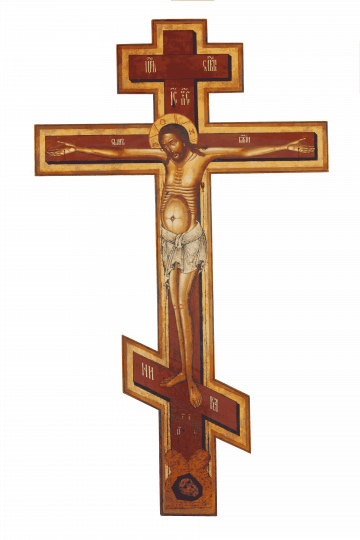Christ on the Cross
(Russia; eighteenth century)
Russia; eighteenth century; 111.4 x 66.1 cm
Icon description
The scene depicts the crucified Christ on a three-armed cross, with a transversely erected lower arm. Based on its size, one can assume that it was the completion of the iconostasis.
At first glance, the representation of the Saviour is relatively simple, but it captivates the viewer with a striking play of light and dark shades, deep simplicity and a thorough emphasis on specific features typical for the environment of the Christian East.
The artistic depiction of the crucifixion of Christ first appears after the year 400 on the portal of the Temple of Saint Sabine in Rome. Up until the ninth century, only a few dared to portray the dead Christ. Custom enjoined to portray him alive, looking ahead. It was not until the eleventh century that Christ began to appear with his head bowed and falling under the weight of his own body. Closed eyes were meant to indicate the mystery of his human nature and foreshadow the coming resurrection. At about the same period, that is in the High Middle Ages, the crucifixion was associated with the depiction of Adam's skull under the cross. The apostle Paul makes this clear in his letters: “Therefore, just as through one man sin entered the world, and death through sin, and thus death spread to all men, because all sinned. Nevertheless death reigned from Adam to Moses, even over those who had not sinned according to the likeness of the transgression of Adam, who is a type of Him who was to come. For if by the one man’s offense death reigned through the one, much more those who receive abundance of grace and of the gift of righteousness will reign in life through the One, Jesus Christ.) For as by one man’s disobedience many were made sinners, so also by one Man’s obedience many will be made righteous.” (Romans 5:12,14,17, 19)
There are faintly visible letters M Л Р Б – Место Лобное Рай Бысть above the skull – the Place of the Skull has become a paradise. On the lower transverse arm, where the feet of Christ rest, one can read the inscription NIKA – Victorious. There are the words Сынъ Божі – Son of God above Christ's outstretched shoulders. The sign made by Pontius Pilate is usually affixed above the head of Christ. Its purpose was to make known the reason for Jesus' condemnation to all participants in the execution or bystanders. This title, an inscription on a wooden board, in Church Slavonic reads: Иисус Назарянин, Царь Иудейский, abbreviated: ІНЦІ. In this particular icon of the cross of Christ, this designation is missing and is replaced by the words Царь Славы – King of Glory


